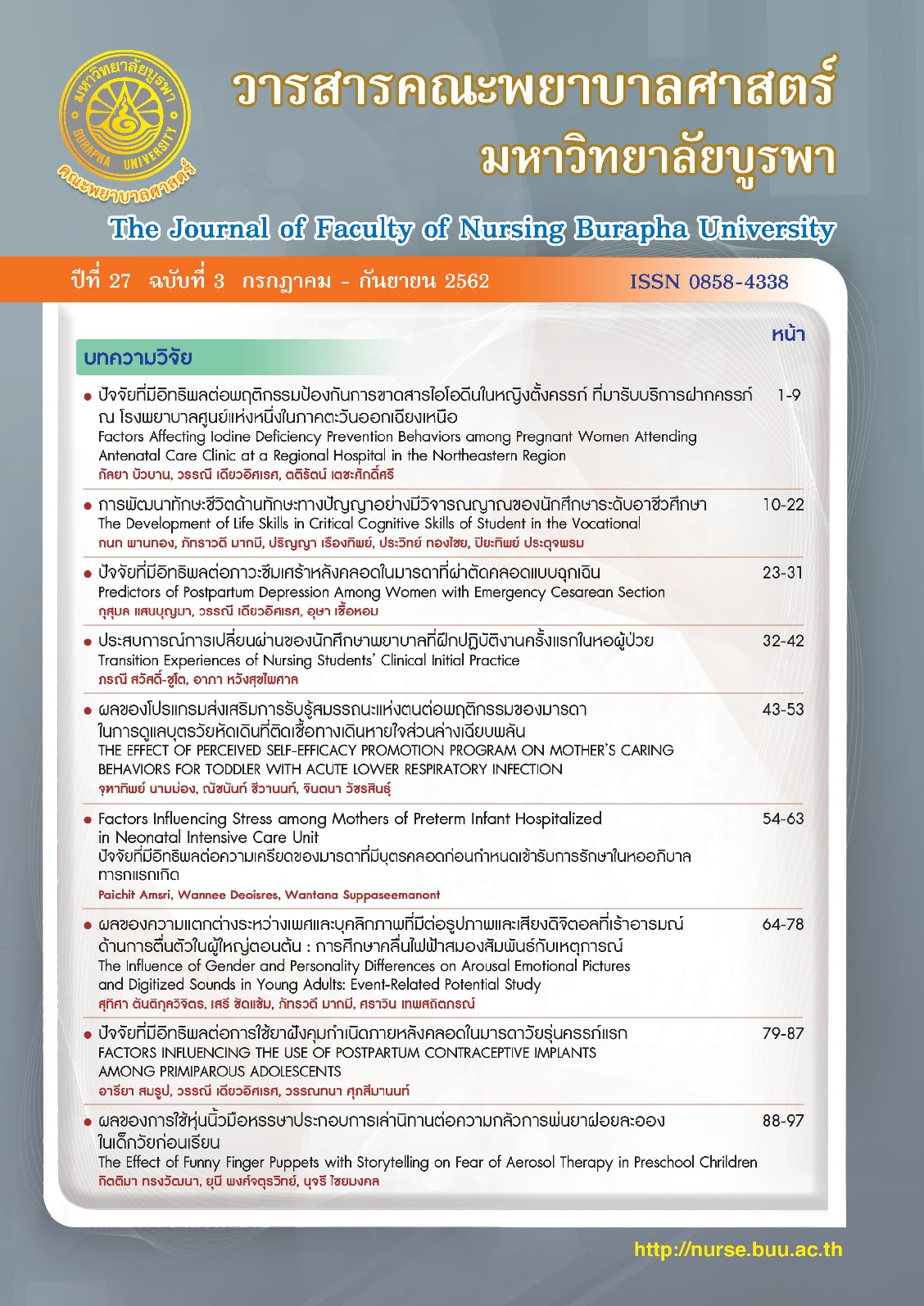ปัจจัยที่มีอิทธิพลต่อภาวะซึมเศร้าหลังคลอดในมารดาที่ผ่าตัดคลอดแบบฉุกเฉิน
คำสำคัญ:
มารดา, ผ่าตัดคลอดแบบฉุกเฉิน, ภาวะซึมเศร้าหลังคลอดบทคัดย่อ
บทคัดย่อ
ภาวะซึมเศร้าหลังคลอดเป็นการเปลี่ยนแปลงที่วิกฤติทางอารมณ์ของมารดาหลังคลอด มีผล
กระทบทั้งต่อมารดาหลังคลอด ทารกและครอบครัว การวิจัยครั้งนี้มีวัตถุประสงค์เพื่อศึกษาปัจจัยที่มีอิทธิพลต่อภาวะซึมเศร้าหลังคลอดในมารดาที่ผ่าตัดคลอดแบบฉุกเฉิน กลุ่มตัวอย่างเป็นมารดาในระยะ 4-8 สัปดาห์หลังคลอด ที่คลอดโดยการผ่าตัดคลอดแบบฉุกเฉิน และมารับบริการตรวจสุขภาพหลังคลอดบุตรหรือพาบุตรมารับบริการที่หน่วยเด็กสุขภาพดีที่โรงพยาบาลระยอง โรงพยาบาลบางละมุง หรือคลินิกเอกชน/โรงพยาบาลเอกชนกรณี จำนวน 98 คน คัดเลือกกลุ่มตัวอย่างแบบสะดวก เก็บข้อมูลโดยใช้แบบสอบถามที่ให้กลุ่มตัวอย่างตอบเอง ได้แก่ แบบสอบถามข้อมูลส่วนบุคคล แบบประเมินภาวะซึมเศร้าหลังคลอด แบบสอบถามความเครียดจากการดูแลบุตร แบบสอบถามความรู้สึกมีคุณค่าในตนเอง และแบบสอบถามการสนับสนุนทางสังคม วิเคราะห์ข้อมูลโดยใช้สถิติพรรณนา และการวิเคราะห์การถดถอยพหุคูณแบบมาตรฐาน
ผลการวิจัยพบมารดาที่ผ่าตัดคลอดแบบฉุกเฉินมีภาวะซึมเศร้าหลังคลอด คิดเป็นร้อยละ 20.20 อายุของมารดา รายได้ของครอบครัว ระยะเวลาของบุตรที่ต้องรับการรักษาที่หออภิบาลทารกแรกเกิดความรู้สึกมีคุณค่าในตนเอง ความเครียดจากการดูแลบุตรและการสนับสนุนทางสังคมร่วมกันทำนายภาวะซึมเศร้าหลังคลอดในมารดาที่ผ่าตัดคลอดแบบฉุกเฉินได้ร้อยละ 56 (Adjusted R2 = .53, F6, 91= 19.307, p < .05) โดยความรู้สึกมีคุณค่าในตนเองมีอิทธิพลต่อภาวะซึมเศร้าหลังคลอดมากที่สุด (β = -.59, p < .05) รองลงมาคือความเครียดจากการดูแลบุตร (β = .20, p < .05) และระยะเวลาของบุตรที่ต้องเข้ารับการรักษาที่หออภิบาลทารกแรกเกิด (β = .17, p < .05)
ผลการศึกษามีข้อเสนอแนะว่าพยาบาลผดุงครรภ์ควรมีการจัดโปรแกรมส่งเสริมความรู้สึกมีคุณค่าในตนเองและการจัดการความเครียดจากการดูแลบุตรหลังคลอดโดยเฉพาะในรายที่บุตรต้องรักษาตัวที่หออภิบาลทารกแรกเกิดเป็นเวลานาน เพื่อป้องกันภาวะซึมเศร้าหลังคลอดในมารดากลุ่มนี้
เอกสารอ้างอิง
Beck, C. T. (2001). Predictors of postpartum depression: An update.Nursing Research, 50(5), 275-285.
Betran, A. P., Ye, J., Moller, A., Zhang, J., Gulmezoglu, A. M., &Yorloni, M. R. (2016).The increasing trend in cesarean section rate: Global, Regional and national estimates: 1990-2014. Plos One, 11(2), 1-12.
Cohen, J. (1992). A power primer.Psychological Bulletin, 11(1). 155-159.
Faul, F., Erdfelder, E., Buchner, A., & Lang, A.-G. (2009). Statistical power analyses using G*3.1: Test for correlation and regression analysis. Behavior Research Methods, 41(4), 1149-1160.
Goker, A., Yanikkerem, E., Demet, M. M., Dikayak, S., Yildirim, Y., & Koyuncu, F. M. (2012).
Postpartum depression: Is mode of delivery a risk factor? ISRN Obstetrics and Gynecology, 1(1), 1-6.
Hoang, O. T., Deoisres, W., & Suppaseemanont, W. (2016). Factors predicting postpartum depression among women in HaiPhong city, Vietnam. Journal of Boromarajonani College of Nursing, Bangkok, 32(1), 92-104.
Lindahl, V., Pearson, J. L., & Colpe, L. (2005). Prevalence of suicidality during pregnancy and the postpartum. Archives of Women's Mental Health, 8(2), 77-87.
Muraca, G. M. & Joseph. K. S. (2014). The association between maternal age and depression. Journal of obstetrics and gynaecology Canada, 39(9), 803-810.
Raksapakde, R., Srisaeng, P., & Ungpansattawon, S. (2018). The relationships of selected factors and postpartum depression among postpartum mothers with hospitalized preterm infants. Journal of Nursing Science & Health, 41(1), 1-11. [In Thai]
Suriyanimitsuk, T., Deoiseres, W. & Wongnum, P. (2015). A causal model of late postpartum depression and its effects on maternal roles. Journal of Health Science Research, 9(1), 16-25. [In Thai]
Sword, W., Landy, C. K., Thabane, L., Watt, S., Krueger, P., Farine, D., & Foster, G. (2011). Is mode of delivery associated with postpartum depression at 6 weeks: A prospective cohort study. An International Journal of Obstertrics and Gyneaecology, 1(1), 966-977.
The American College of Obstertricians and Gynecologists. (2015). Cesarean Birth (C-section). Retrieved From https://www.acog.org/Patients/FAQs/Cesarean-Birth-C-Section
Vacharaporn, K., Pitanupong, J. &Samangsri, N. (2003). Development of the Edinburgh postnatal depression scale Thai version. Journal of Mental Health of Thailand, 11(3), 164-169. [In Thai]
Wongvisetsirikul, P. (1998). Relationships among personal factors, marital relationship, and
postpartum anxiety and depression in first-time mother, Doctoral dissertation Faculty of Nursing, Mahidol University. [In Thai]
World Health Organization. (2015). WHO statement on caesarean section rates. Retrieved from http://apps.who.int/iris/bitstream/10665/161442/1/WHO_RHR_15.02_eng.pdf?
Yang, S-N., Shen, L-J., Ping, T., Wang, Y-C., & Chien, C-W. (2011). The delivery mode and seasonal variation are associated with the development of postpartum depression. Journal of Affective Disorders, 132(1), 158-164.
Yokote, N. (2008). Women’s experiences of labor, surgery and first postnatal week by an emergency cesarean section. Journal of Japan Academy of Midwifery, 22(1), 37-47.
Youngdee, K. & Roomruangwong, C. (2016). Depression after childbirth among mothers with obstetric complications in King Chulalongkorn Memorial Hospital. Chulalongkorn Medical Journal, 60(5), 561-574.





